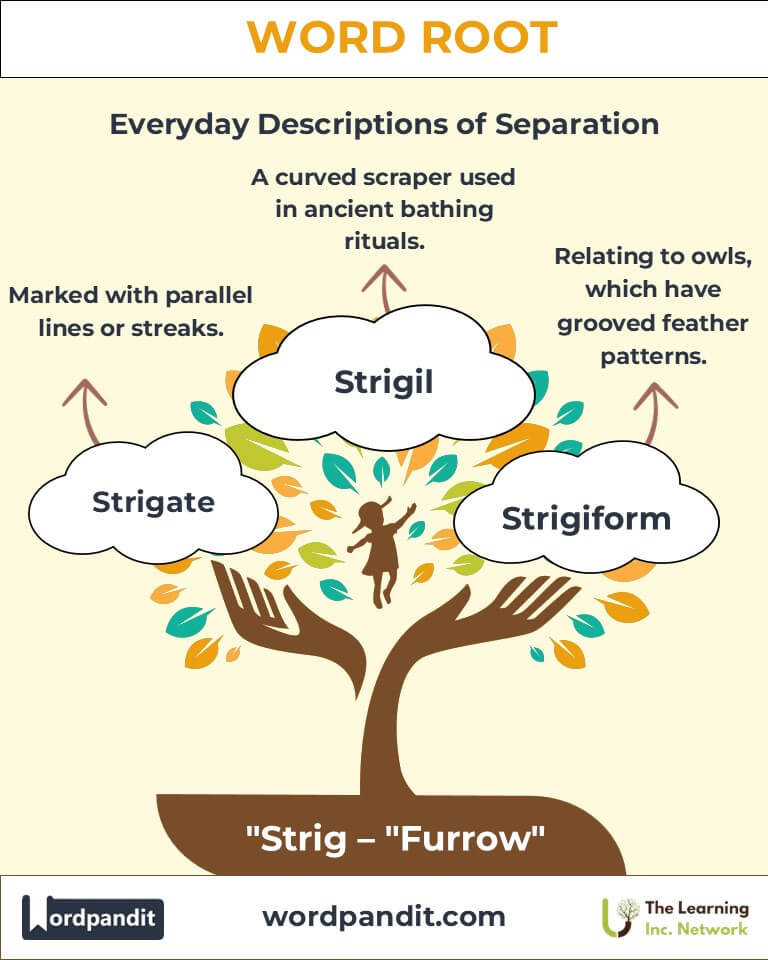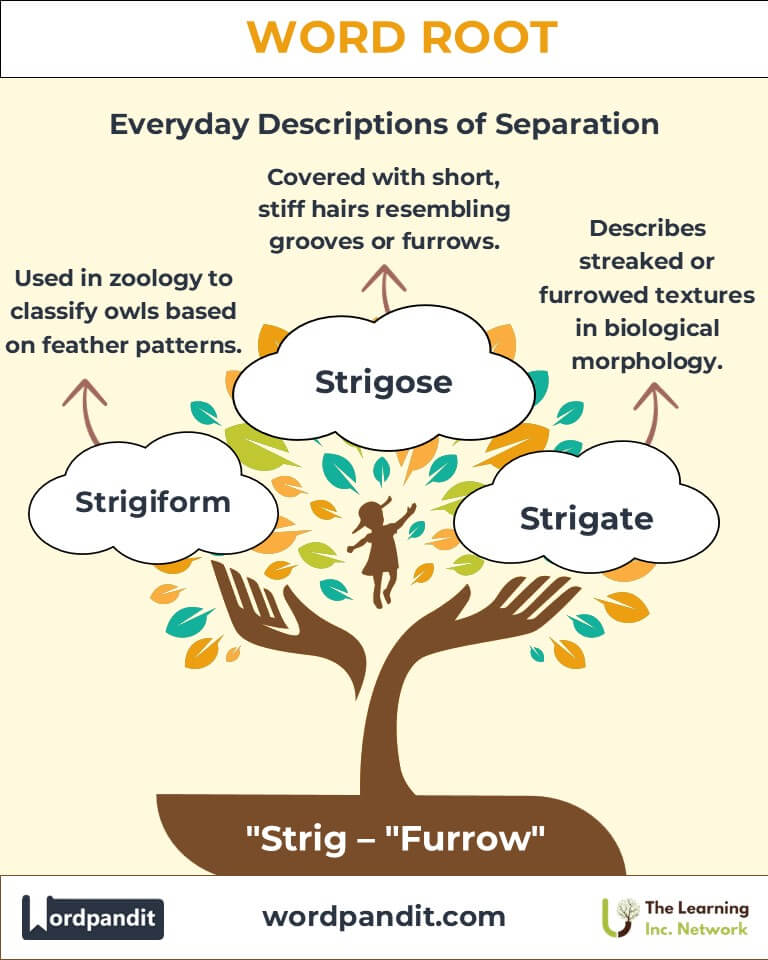Strig: The Root of Furrows in Language and Science
Byline: Uncover the depth of the word root "Strig," originating from the Latin word meaning "furrow." Found in unique terms like "strigil" and "strigose," this root connects the ancient art of self-care with botanical descriptions, demonstrating its linguistic richness and versatility.

Table of Contents
- Introduction: The Essence of Strig
- Etymology and Historical Journey
- Mnemonic: Unlocking the Power of Strig
- Common Strig-Related Terms
- Strig Through Time
- Strig in Specialized Fields
- Illustrative Story: Strig in Action
- Cultural Significance of Strig
- The Strig Family Tree
- FAQs about the Strig Word Root
- Test Your Knowledge: Strig Word Root Quiz
- Conclusion: The Enduring Legacy of Strig
1. Introduction: The Essence of Strig
The word root "Strig," derived from the Latin striga meaning "furrow," finds its place in both historical and scientific vocabularies. Pronounced "strihg," it primarily evokes imagery of grooves or channels. From ancient tools for grooming to the structure of plant surfaces, this root weaves through diverse domains, underscoring its adaptability and enduring significance.

2. Etymology and Historical Journey
The root "Strig" traces its origins to Latin, where striga referred to a furrow or groove. This concept expanded to describe tools and natural formations marked by linear patterns. One notable historical application of this root appears in the term strigil, a curved scraper used in ancient Roman and Greek bathing practices to remove dirt and oil from the skin.
As the root traveled through time, its meaning broadened, influencing fields like botany and morphology. In English, "Strig" began to describe ridged or grooved structures in both artificial and natural contexts.
3. Mnemonic: Unlocking the Power of Strig
Visualize a farmer plowing neat furrows in a field, each groove meticulously straight and deep. This imagery ties the root to its meaning of furrows or grooves, making it easier to associate with related terms.
Mnemonic Device: "Strig furrows through history, leaving grooves in tools, plants, and language."
4. Common Strig-Related Terms
- Strigil (strih-jil): A curved metal scraper used in ancient bathing rituals.
- Example: "The athlete cleansed her skin with a strigil after the race."
- Strigose (strih-gohs): Covered with short, stiff hairs resembling grooves or furrows.
- Example: "The plant’s strigose leaves helped it retain moisture in arid climates."
- Strigate (strih-gayt): Marked with parallel lines or streaks.
- Example: "The insect’s wings were strigate, aiding in camouflage among grass blades."
- Strigiform (strih-jih-form): Relating to owls, many of which have grooved feather patterns.
- Example: "The strigiform design of the owl’s plumage helps it fly silently."
5. Strig Through Time
- Ancient Tools:
- Strigils: In Roman and Greek baths, they symbolized hygiene and refinement.
- Botanical Descriptions:
- Strigose: Highlighted adaptive features of plants, emphasizing evolutionary ingenuity.
6. Strig in Specialized Fields
- Botany: Terms like "strigose" describe plant surfaces with grooved or hair-like structures, aiding in water retention or defense.
- Archaeology: The strigil remains a significant artifact, providing insights into ancient personal care practices.
- Zoology: The term "strigiform" classifies owls, linking the root’s essence to the structured patterns in feathers.
7. Illustrative Story: Strig in Action
In a bustling Roman bathhouse, Marcus prepared to cleanse himself after a long day. With a strigil in hand, he scraped away the day’s grime, marveling at how this simple tool left furrowed patterns on his skin. Centuries later, a botanist observed the strigose leaves of a desert plant, noting how their fine grooves mirrored Marcus's ancient tool. Across time and space, "Strig" left its mark, bridging human innovation and nature’s design.
8. Cultural Significance of Strig
The "Strig" root captures the intersection of practicality and aesthetics. Ancient cultures valued the strigil for its utility and its symbolic role in rituals of purification. Today, botanical terms like "strigose" echo this cultural reverence for structure and function, emphasizing the root’s enduring legacy.

9. The Strig Family Tree
- Plow (Old English): To make furrows in the soil.
- Ruga (Latin): Wrinkle or fold, akin to grooves in texture.
- Linea (Latin): Line or streak, associated with grooves or furrows.

10. FAQs About " Strig "
Q: What does "Strig" mean?
A: "Strig" originates from the Latin word striga, meaning a furrow or groove. It symbolizes linear or ridged patterns found in tools, plant structures, and more.
Q: What is a strigil, and why was it significant in ancient times?
A: A strigil is a tool for scraping skin during bathing, used in ancient Greek and Roman baths to remove dirt, sweat, and oil. It symbolized hygiene and refinement in those cultures.
Q: How is "Strig" applied in botany?
A: "Strig" in botany refers to surfaces with furrows or stiff hairs. For example, "strigose" describes plant surfaces covered with short, stiff hairs arranged in furrow-like patterns, aiding in moisture retention or defense.
Q: What does "strigiform" mean, and how does it relate to zoology?
A: "Strigiform" pertains to owls, emphasizing their feather patterns, which often have grooves aiding in silent flight for stealthy hunting.
11. Test Your Knowledge: " Strig " Mastery Quiz
1. What does the root "Strig" signify?
2. What was a strigil used for?
3. Which term describes leaves with short, stiff hairs?
4. How does "strigiform" relate to animals?
5. What does "strigate" describe?
12. Conclusion: The Living Legacy of Strig
The root "Strig" underscores the beauty and utility of grooves and furrows, whether in ancient artifacts or natural formations. As it continues to shape language in fields like botany and zoology, "Strig" reminds us of the intricate patterns that define our world. Let this root inspire you to notice the grooves and details that enrich life, bridging past and present through the lens of language.












